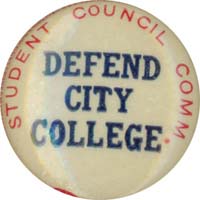
rapp-coudert & ccny
The main focus of the Rapp-Coudert Committee becomes City College, the largest and most famous of the city’s public colleges.
 William Canning, an instructor in the history department appears before
the committee and names over fifty staff and faculty at CCNY as CP members.
CCNY has at least three informers, including Oscar Zeichner, a history instructor
and Annettte Sherman Gottsegen, a clerk. In this illustration, William Canning
is depicted as a puppet being manipulated by an evil giant, and is encouraged
from the sidelines by the Ku Klux Klan, bankers, and a college administrator.
William Canning, an instructor in the history department appears before
the committee and names over fifty staff and faculty at CCNY as CP members.
CCNY has at least three informers, including Oscar Zeichner, a history instructor
and Annettte Sherman Gottsegen, a clerk. In this illustration, William Canning
is depicted as a puppet being manipulated by an evil giant, and is encouraged
from the sidelines by the Ku Klux Klan, bankers, and a college administrator.
 Annette Sherman Gottsegen testifies against John Kenneth Ackley, the CCNY
registrar.
Annette Sherman Gottsegen testifies against John Kenneth Ackley, the CCNY
registrar.
 Acting City College President Harry Noble Wright assists the Rapp-Coudert
Committee in its investigation of City College faculty and staff by submitting
a list of potential CCNY informers.
Acting City College President Harry Noble Wright assists the Rapp-Coudert
Committee in its investigation of City College faculty and staff by submitting
a list of potential CCNY informers.
 President Wright suspends eleven CCNY professors and staff members for allegedly
giving false testimony to the Rapp-Coudert Committee when they deny Communist
Party membership during hearings.
President Wright suspends eleven CCNY professors and staff members for allegedly
giving false testimony to the Rapp-Coudert Committee when they deny Communist
Party membership during hearings.
 Suspended CCNY professors attend a peace strike in Lewisohn Stadium on April
23, 1941, one day after their suspensions. Seated left to right are David
Cohen, librarian; Samuel Margolies, librarian; Walter Neff, psychology;
Saul Bernstein, biology; John Kenneth Ackley, registrar; and Morris Cohen,
chemistry instructor. Standing, left to right are Louis Balamuth, physics
; Jesse Mintus, registrar’s office; and Sidney Eisenberger, chemistry.
Suspended CCNY professors attend a peace strike in Lewisohn Stadium on April
23, 1941, one day after their suspensions. Seated left to right are David
Cohen, librarian; Samuel Margolies, librarian; Walter Neff, psychology;
Saul Bernstein, biology; John Kenneth Ackley, registrar; and Morris Cohen,
chemistry instructor. Standing, left to right are Louis Balamuth, physics
; Jesse Mintus, registrar’s office; and Sidney Eisenberger, chemistry.
 John Kenneth Ackley, CCNY Registrar, is first to be formally tried by the
NYC Board of Higher Education’s trial committee. Individuals named
by two witnesses before Rapp-Coudlert as CP members are either terminated
by Acting President Wright, resign under pressure, or are dismissed after
trials.
John Kenneth Ackley, CCNY Registrar, is first to be formally tried by the
NYC Board of Higher Education’s trial committee. Individuals named
by two witnesses before Rapp-Coudlert as CP members are either terminated
by Acting President Wright, resign under pressure, or are dismissed after
trials.






